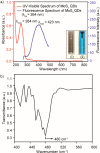Dual Role of MoS2 Quantum Dots in a Cross-Dehydrogenative Coupling Reaction
- PMID: 36855472
- PMCID: PMC9955124
- DOI: 10.1021/acsorginorgau.1c00040
Dual Role of MoS2 Quantum Dots in a Cross-Dehydrogenative Coupling Reaction
Abstract
Modern day research focuses on the development of greener and eco-friendlier protocols to fabricate biologically relevant targets with minimal waste generation. C-C bond formation reactions are of prime importance in this regard. In a typical photocatalytic hydrogen evolution reaction, three components are used, viz, catalyst, photosensitizer, and sacrificial amine donor. Among these, the photosensitizer and sacrificial amine donors are wasted at the end of the reaction. Considering these drawbacks, in this work, we have developed a methodology targeted at the utilization of sacrificial amine donors for C-H functionalization with MoS2 quantum dots (QDs) as the catalyst as well as the photosensitizer. QDs indeed emerged to be an active participant in the heterogeneous electron transfer process. This concept opens up new possibilities in the field of nanomaterial-based photomediated organic transformations without the aid of any external photosensitizers via a clean and sustainable protocol with no side product.
© 2022 The Authors. Published by American Chemical Society.
Conflict of interest statement
The authors declare no competing financial interest.
Figures







References
-
- Tian Z.; Zhang X.; Li D.; Zhou D.; Jing P.; Shen D.; Qu S.; Zboril R.; Rogach A. L. Full-Color Inorganic Carbon Dot Phosphors for White-Light-Emitting Diodes. Adv. Opt. Mater. 2017, 5, 1700416.10.1002/adom.201700416. - DOI
LinkOut - more resources
Full Text Sources
